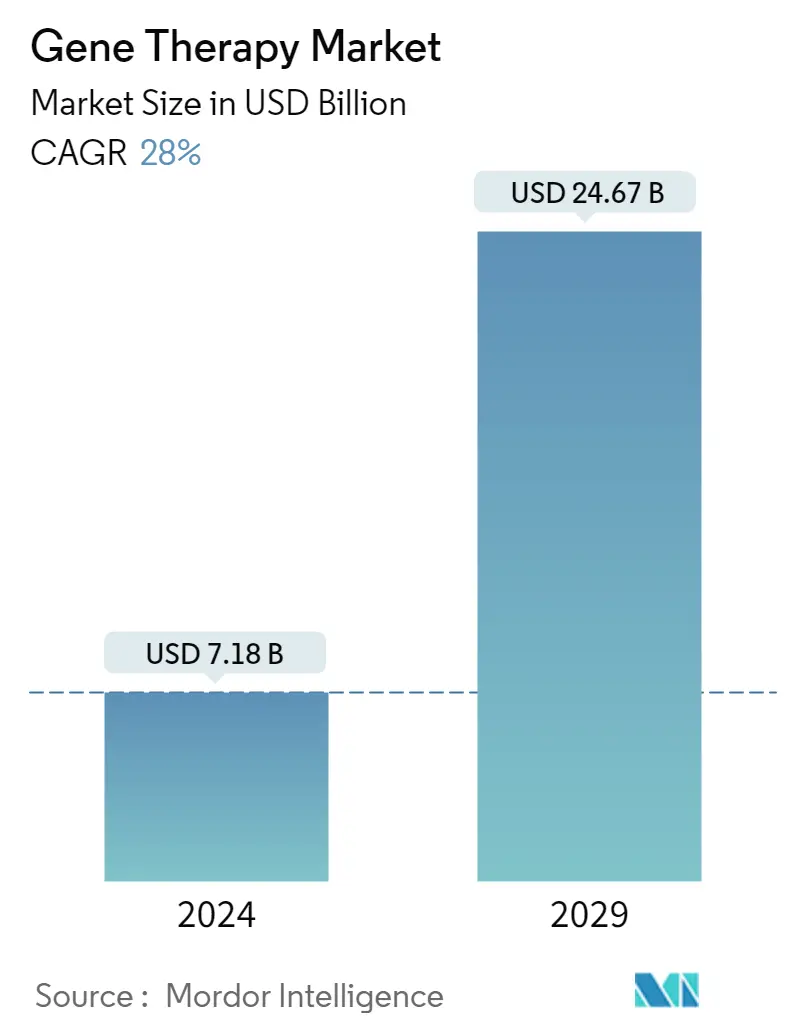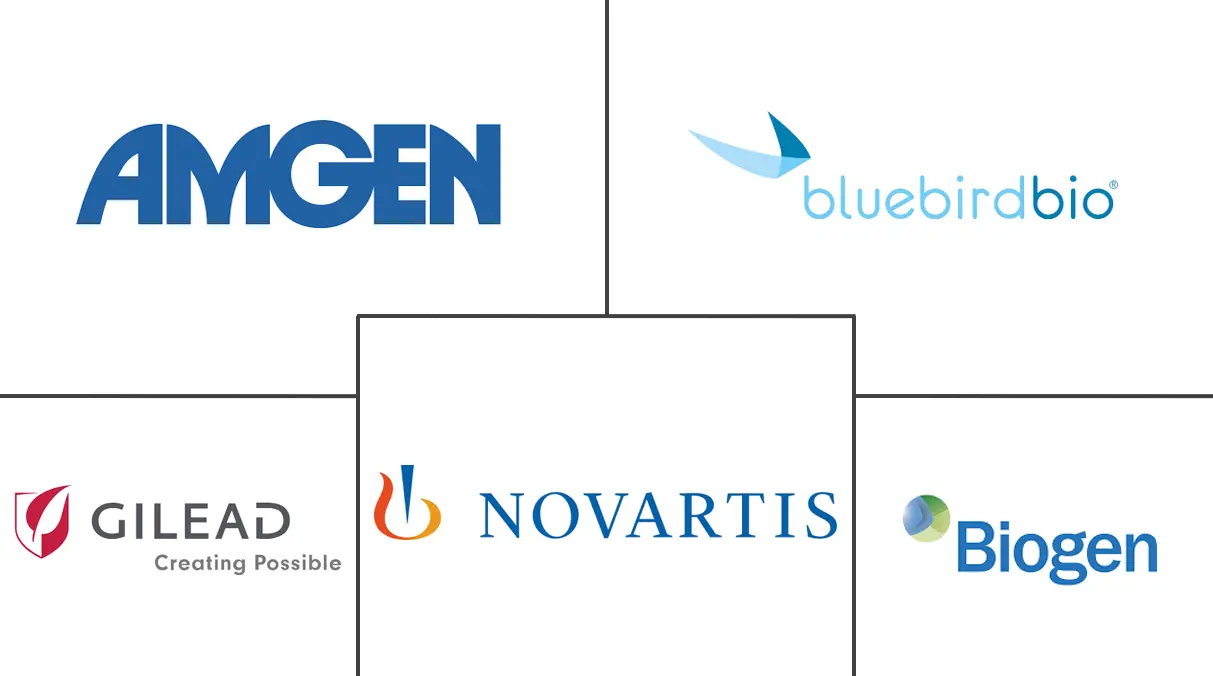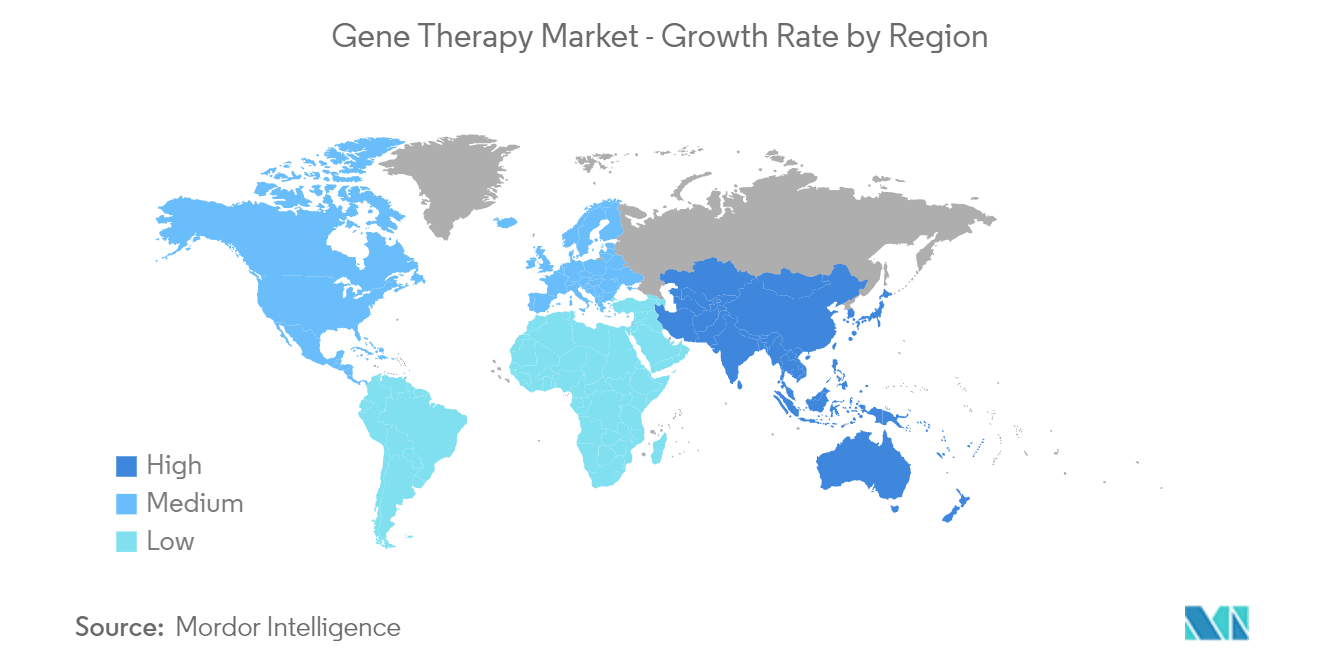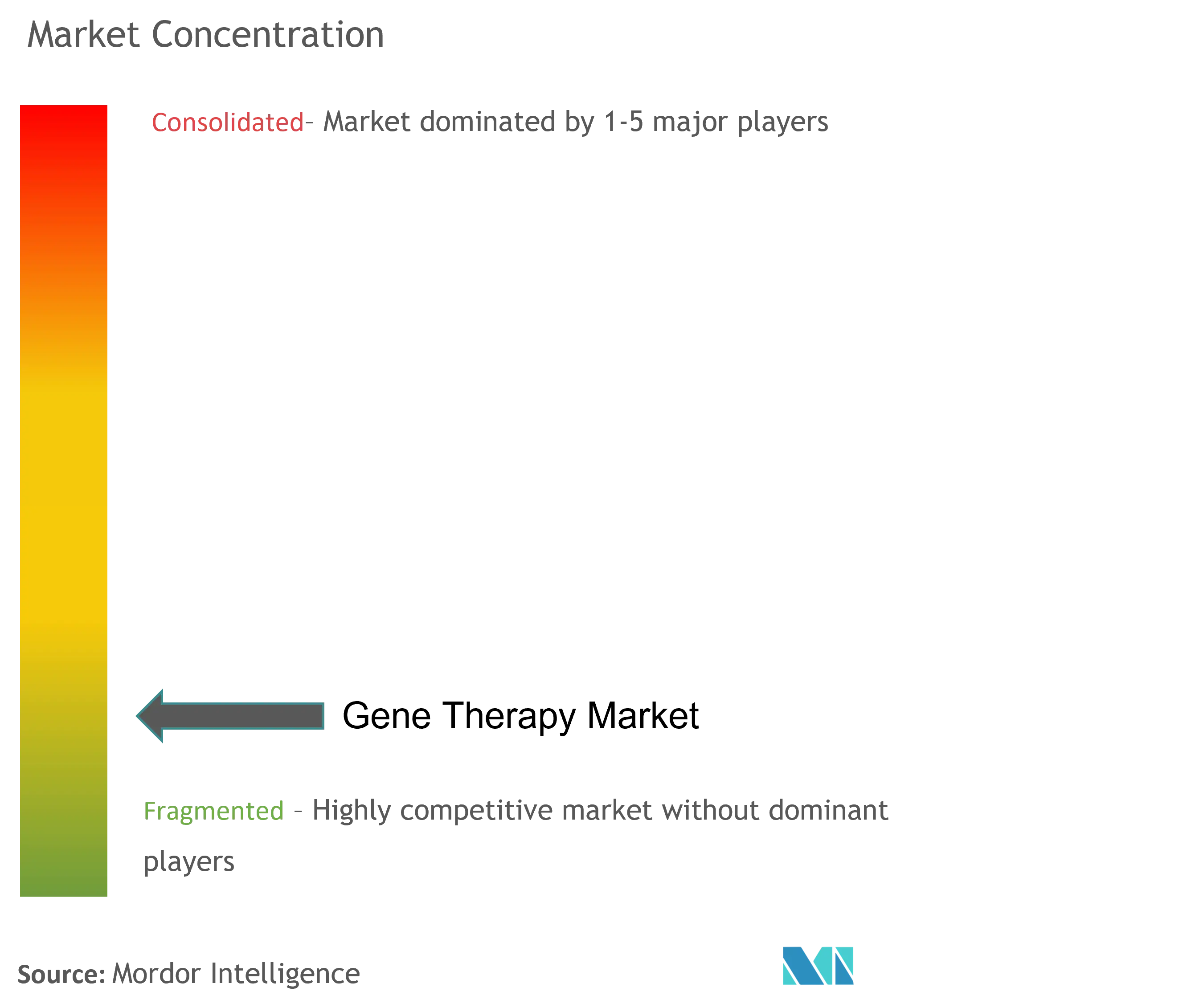Gene Therapy Market Size

| Study Period | 2019 - 2029 |
| Market Size (2024) | USD 7.18 Billion |
| Market Size (2029) | USD 24.67 Billion |
| CAGR (2024 - 2029) | 28.00 % |
| Fastest Growing Market | Asia Pacific |
| Largest Market | North America |
Major Players
*Disclaimer: Major Players sorted in no particular order |
Gene Therapy Market Analysis
The Gene Therapy Market size is estimated at USD 7.18 billion in 2024, and is expected to reach USD 24.67 billion by 2029, growing at a CAGR of 28% during the forecast period (2024-2029).
The COVID-19 pandemic had a positive effect on the gene therapy market. Gene and cell therapy technology were extensively used in developing vaccines to treat COVID-19. For example, in January 2021, vaccine candidates developed by Mass General Brigham were made by utilizing gene-therapy technology that elicited robust immune responses in animal models for the treatment of COVID-19. The vaccine candidate was named AAVCOVID, and the researchers received a USD 2.1 million grant to further develop the technology from the Bill & Melinda Gates Foundation. The developed vaccine was far more convenient than the ones sold on the market, as it had a single dose and could be stored at room temperature. Also, per a January 2021 published article in Hindawi Journal, the treatment of coronavirus from the perspective of RNA interference-based gene therapy offered a more direct approach to combating viral genes and has a promising future. Thus, the COVID-19 pandemic led to an increased demand for gene-based therapy for COVID-19.
The major factors propelling the market's growth include technological advancements, rising investments in research and development, and the growing prevalence of target diseases.
Research and development (R&D) investment is also expected to affect the market significantly. Several companies aim to build a gene therapy platform with a strategy focused on establishing a transformational portfolio through in-house capabilities and enhancing those capabilities through strategic collaborations, expansion of R&D activities, and potential licensing, merger, and acquisition activities. For instance, in January 2022, the Cystic Fibrosis Foundation reported investing in SalioGen Therapeutics to support the company's preclinical research into novel gene therapy for cystic fibrosis. Salonen's Gene Coding approach is designed to turn on, turn off, or modify the function of any gene in the genome. Furthermore, in March 2021, ElevateBio, one of the leading biotech companies focused on gene-based therapies, raised USD 525 million to advance its cell and gene therapy technologies.
In addition, the rise in approvals for gene therapies from international regulatory agencies is expected to drive market growth. For instance, in August 2022, the USFDA approved Zynteglo (betibeglogene autotemcel), the first cell-based gene therapy for treating adult and pediatric patients with beta-thalassemia. Such approvals are expected to drive market growth due to the rise in the development of gene therapies.
However, the lack of standard regulations and the high price of products hinder the gene therapy market's growth.
Gene Therapy Market Trends
This section covers the major market trends shaping the Gene Therapy Market according to our research experts:
Cancer is Expected to Hold Significant Market Share in the Indication Segment over the Forecast Period
The factors boosting segment growth are the increasing burden of cancer disorder, the growing focus on research to develop an effective cancer treatment, and rising investments in cancer research.
For instance, according to the ACS 'Cancer Facts & Figures 2022', around 1,918,030 new cancer cases and 609,360 deaths due to cancers are estimated to be reported in the United States in 2022. In the treatment of cancer, various gene therapy strategies are currently employed. These include anti-angiogenic gene therapy, pro-drug activating suicide gene therapy, gene therapy-based immune modulation, oncolytic virotherapy, correction/compensation of gene defects, antisense, genetic manipulation of apoptotic and tumor invasion pathways, and RNAi strategies. The cancer types, such as brain, lung, breast, pancreatic, liver, colorectal, prostate, bladder, head and neck, skin, ovarian, and renal cancer, have been the target of these therapies.
A growing focus on developing effective therapies for cancer is also contributing to the market growth. For instance, in March 2021, the USFDA approved Abecma (idecabtagene vicleucel), a cell-based gene therapy to treat adult patients with multiple myeloma who have not responded to or whose disease has returned after at least four last lines (different types) of treatment. Abecma is the first cell-based gene therapy approved by the FDA for treating multiple myeloma.
Many key players in the market are focused on adopting strategies, such as mergers and acquisitions, on enhancing their product portfolio, which is expected to propel market growth over the forecast period. For instance, in June 2021, CyGenica secured funding from SOSV Investments LLC, a venture capital company, to accelerate cancer and rare genetic disease therapy.
Thus, such developments significantly contribute to the overall market's growth.

North America Dominates the Market and is Expected to do Same over the Forecast Period.
Within North America, the United States has held a major share of the market. The major factors fueling the market growth are the increasing number of investments by the government, advancements in research and development about gene therapy, and the growing prevalence of target diseases.
For instance, as per the United States Center for Disease Control and Prevention article on spinal muscular atrophy (SMA) updated in December 2021, SMA is a genetic disorder that affects around 1 in every 10,000 people. Therefore, it is one of the most common rare diseases. The numbers indicate the growing demand for gene therapy in the United States. In May 2022, the FDA approved the drug, Evrysdi for babies under two months old with spinal muscular atrophy. Evrysdi is an SMN-enhancing therapy that works by targeting the SMN2 gene. Such product approvals in the region are adding to the growth of the market.
Several initiatives are being launched about gene therapy. For instance, as per an October 2021 update by the National Institutes of Health (NIH), the NIH, USFDA, 10 pharmaceutical companies, and 5 non-profit organizations have partnered to accelerate the development of gene therapies for the 30 million Americans who suffer from a rare disease. Such initiatives are anticipated to increase the demand for gene therapy, thereby contributing to market growth.
In addition, rising investments form the Government of United States is also expected to drive the growth of the market growth. For instance, the NIH funding on Gene Therapy in the United States is USD 403 million and USD 481 million in the year 2020 and 2021 respectively. The rising investment in the gene therapy in the United States will lead rise in development of gene therapies in this region, driving the market growth.
Thus, due to the above-mentioned developments, the market is expected to witness significant growth over the forecast period.

Gene Therapy Industry Overview
The gene therapy market is highly competitive and consists of several significant players. Companies like Amgen Inc., Bluebird Bio, Gilead Sciences, Inc., Novartis AG, Orchard Therapeutics, Sibiono GeneTech Co. Ltd, Spark Therapeutics (Roche AG), and UniQure NV hold a substantial market share. They have various strategic alliances, such as collaborations and acquisitions, along with the launch of advanced products to secure their position in the global market.
Gene Therapy Market Leaders
-
Gilead Sciences, Inc.
-
Novartis
-
Amgen Inc.
-
Bluebird Bio
-
Biogen Inc
*Disclaimer: Major Players sorted in no particular order

Gene Therapy Market News
- In October 2022, Sarepta Therapeutics applied to the US FDA to grant accelerated approval to the gene therapy S (delandistrogene moxeparvovec) for the treatment of Duchenne Muscular Dystrophy (DMD).
- In August 2022, the US FDA approved Zynteglo (betibeglogene autotemcel), the first cell-based gene therapy for treating adult and pediatric patients with beta-thalassemia who require regular red blood cell transfusions.
Gene Therapy Market Report - Table of Contents
1. INTRODUCTION
- 1.1 Study Assumptions and Market Definition
- 1.2 Scope of the Study
2. RESEARCH METHODOLOGY
3. EXECUTIVE SUMMARY
4. MARKET DYNAMICS
- 4.1 Market Overview
-
4.2 Market Drivers
- 4.2.1 Rising Investments in Research and Development
- 4.2.2 Technological Advancements
- 4.2.3 Growing Prevalence of Target Diseases like Cancer
-
4.3 Market Restraints
- 4.3.1 Lack of Standard Regulations
- 4.3.2 High Price of Products
-
4.4 Porter's Five Forces Analysis
- 4.4.1 Threat of New Entrants
- 4.4.2 Bargaining Power of Buyers/Consumers
- 4.4.3 Bargaining Power of Suppliers
- 4.4.4 Threat of Substitute Products
- 4.4.5 Intensity of Competitive Rivalry
5. MARKET SEGMENTATION (Market Size by Value- USD million)
-
5.1 By Indication
- 5.1.1 Cancer
- 5.1.2 Metabolic Disorders
- 5.1.3 Eye Disorders
- 5.1.4 Spinal Muscular Atrophy
- 5.1.5 Other Indications
-
5.2 By Technology
- 5.2.1 Adeno Virus Vector
- 5.2.2 Adeno-associated Virus Vector
- 5.2.3 Lentiviral Vector
- 5.2.4 Retroviral Vector
- 5.2.5 Herpes Virus Vector
- 5.2.6 Other Technologies
-
5.3 Geography
- 5.3.1 North America
- 5.3.1.1 United States
- 5.3.1.2 Canada
- 5.3.1.3 Mexico
- 5.3.2 Europe
- 5.3.2.1 Germany
- 5.3.2.2 United Kingdom
- 5.3.2.3 France
- 5.3.2.4 Italy
- 5.3.2.5 Spain
- 5.3.2.6 Rest of Europe
- 5.3.3 Asia-Pacific
- 5.3.3.1 China
- 5.3.3.2 Japan
- 5.3.3.3 India
- 5.3.3.4 Australia
- 5.3.3.5 South Korea
- 5.3.3.6 Rest of Asia-Pacific
- 5.3.4 Middle-East and Africa
- 5.3.4.1 GCC
- 5.3.4.2 South Africa
- 5.3.4.3 Rest of Middle East and Africa
- 5.3.5 South America
- 5.3.5.1 Brazil
- 5.3.5.2 Argentina
- 5.3.5.3 Rest of South America
6. COMPETITIVE LANDSCAPE
-
6.1 Company Profiles
- 6.1.1 Amgen Inc.
- 6.1.2 Biogen Inc.
- 6.1.3 Bluebird Bio Inc.
- 6.1.4 Gilead Sciences Inc. (Kite Pharma)
- 6.1.5 Novartis AG
- 6.1.6 F. Hoffmann-La Roche Ltd (Spark Therapeutics)
- 6.1.7 UniQure NV
- 6.1.8 Abeona Therapeutics Inc.
- 6.1.9 Generation Bio
- 6.1.10 Poseida Therapeutics
- 6.1.11 Astellas Pharma
- 6.1.12 Voyager Therapeutics Inc.
- *List Not Exhaustive
7. MARKET OPPORTUNITIES AND FUTURE TRENDS
** Subject To AvailablityGene Therapy Industry Segmentation
As per the scope of this report, gene therapy is an advanced medical treatment that involves the transfer of a standard or healthy gene to replace a defective gene in a cell. It can cure various chronic and genetic disorders in human beings, for which no final cure has been developed. The market is segmented by Indication (Cancer, Metabolic Disorders, Eye Disorders, Spinal Muscular Atrophy, and Other Indications), Technology (Adeno Virus Vector, Adeno-associated Virus Vector, Lentiviral Vector, Retroviral Vector, Herpes Virus Vector, and Other Technologies), and Geography (North America, Europe, Asia-Pacific, Middle-East and Africa, and South America). The market report also covers the estimated market sizes and trends for 17 countries across major regions globally. The report offers the value (in USD million) for the above segments.
| By Indication | Cancer | |
| Metabolic Disorders | ||
| Eye Disorders | ||
| Spinal Muscular Atrophy | ||
| Other Indications | ||
| By Technology | Adeno Virus Vector | |
| Adeno-associated Virus Vector | ||
| Lentiviral Vector | ||
| Retroviral Vector | ||
| Herpes Virus Vector | ||
| Other Technologies | ||
| Geography | North America | United States |
| Canada | ||
| Mexico | ||
| Geography | Europe | Germany |
| United Kingdom | ||
| France | ||
| Italy | ||
| Spain | ||
| Rest of Europe | ||
| Geography | Asia-Pacific | China |
| Japan | ||
| India | ||
| Australia | ||
| South Korea | ||
| Rest of Asia-Pacific | ||
| Geography | Middle-East and Africa | GCC |
| South Africa | ||
| Rest of Middle East and Africa | ||
| Geography | South America | Brazil |
| Argentina | ||
| Rest of South America |
Gene Therapy Market Research FAQs
How big is the Gene Therapy Market?
The Gene Therapy Market size is expected to reach USD 7.18 billion in 2024 and grow at a CAGR of 28% to reach USD 24.67 billion by 2029.
What is the current Gene Therapy Market size?
In 2024, the Gene Therapy Market size is expected to reach USD 7.18 billion.
Who are the key players in Gene Therapy Market?
Gilead Sciences, Inc., Novartis, Amgen Inc., Bluebird Bio and Biogen Inc are the major companies operating in the Gene Therapy Market.
Which is the fastest growing region in Gene Therapy Market?
Asia Pacific is estimated to grow at the highest CAGR over the forecast period (2024-2029).
Which region has the biggest share in Gene Therapy Market?
In 2024, the North America accounts for the largest market share in Gene Therapy Market.
What years does this Gene Therapy Market cover, and what was the market size in 2023?
In 2023, the Gene Therapy Market size was estimated at USD 5.61 billion. The report covers the Gene Therapy Market historical market size for years: 2019, 2020, 2021, 2022 and 2023. The report also forecasts the Gene Therapy Market size for years: 2024, 2025, 2026, 2027, 2028 and 2029.
What are the key challenges faced in the Gene Therapy Market?
The key challenges faced in the Gene Therapy Market are a) Limited availability and scalability of gene therapy treatments b) Ethical considerations and potential risks associated with gene editing
Gene Therapy Industry Report
The gene therapy market is witnessing remarkable growth, driven by an increase in regulatory approvals and a rising demand for innovative therapies. This market overview highlights the therapeutic areas such as neurology, oncology, and hepatology, which are propelled by advancements in genomics and targeted therapies. Despite challenges like high costs and supply chain complexities, the effectiveness and long-term benefits of gene therapies are driving market expansion.
The market forecast indicates a significant potential for growth, with the competitive landscape being vibrant. Key players are engaging in strategic collaborations to enhance their product offerings. The market growth is further supported by the increasing approval of gene therapy products, underscoring the market's potential for further innovation.
Industry research shows that the gene therapy sector presents significant opportunities, especially in developing treatments for neurological conditions that lack effective options. This market report provides a comprehensive analysis, including industry statistics and market segmentation by indication and technology.
The report pdf offers detailed industry information, including a historical overview and future outlook. The market review includes insights into market leaders and their strategic collaborations. The market predictions suggest continued advancement and commercial success in gene therapy.
Industry analysis reveals that the gene therapy market is set to expand, with industry reports highlighting the value of these therapies in various therapeutic areas. The market data indicates a promising market outlook, with market trends showing a rise in the adoption of gene therapies.
The industry outlook is positive, with market segmentation covering different regions such as North America, Europe, Asia-Pacific, Middle East and Africa, and South America. The industry size is expected to grow, with market value reflecting the increasing demand for innovative therapies.
Research companies are focusing on developing new gene therapy products, with industry sales projected to rise. The report example provides a detailed analysis of the competitive landscape, highlighting the largest companies in the gene therapy market.
In conclusion, the gene therapy market is poised for significant growth, with market leaders driving innovation and expansion. The market overview and market predictions indicate a bright future for this sector, with industry trends showing a positive trajectory for gene therapy products.



